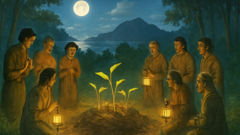Introduction
On islands carved from volcanic breath and coral bone, where the ocean sings in a different key and the wind keeps the same secrets, the people of Maluku have always read their lives against the land. They speak of kinship with the forest, a reverence for the swells of the sea, and the old wordless negotiations between human hunger and the abundance that answers it. Among these islands there is a story that names the very staples of their daily bread — a myth that explains why the roots rise from the earth like promises kept. It is the tale of Hainuwele: a girl whose coming was strange, whose gifts were uncanny, and whose end was the seed of life. In the telling, the myth folds together wonder and warning. It presents a world in which the miraculous can provoke envy, where generosity can unsettle a community’s sense of measure, and where death does not end but begins a new order. This story does not ask only to be heard; it asks to be felt: the dampness of newly turned soil beneath palm fronds, the scent of smoke and sago in the night, the bright eye of a tuber glowing as if lit from within. To read the Hainuwele myth is to listen to an older kind of ecology — one that traces kinship through the body of a being and maps the origin of food, ritual, and law across the contours of landscape and memory. In the layers of the narrative you will find how a single life becomes a harvest, how grief becomes a garden, and how the first crops teach people to remember what came before them.
The Strange Birth and the Gifts of Hainuwele
Long before preferences hardened into feasts and fields, before the patterning of gardens and laws, the people of a certain island on the edges of the Maluku archipelago lived in a world of foraging and song. They read the stars for the tides, watched the migratory paths of birds for weather, and cleared patches of forest with ceremonies that honored what they cut. It was a life braided with ritual: names remembered, debts sung, and reciprocity practiced in small, exacting gestures. Into this life came Hainuwele, whose name did not first appear in family registers but in a series of uncanny incidents that altered the community’s economy of wonder.
Her coming was narrated like an effect of the sea and the forest at once. Different tellings place her birth in slivers of coconut or in the hollow of a log, or carried within the belly of a voyager, but all versions agree on the element of surprise — she arrived like a gift without owner, sudden and unclaimed. She was a little girl with a face people would try to read as they read the weather: open, attentive, occasionally inscrutable. There were those who took her in, who fed her and taught her the names of shell and bird and shadow. She learned to weave, to paddle, to listen to the stories the elders told about the origin of things. And from the earliest hours of her life Hainuwele produced objects not by craft but by a bodily mystery that left those who saw it alternately rapt and aghast.
It is said that when she relieved herself, the earth accepted not mere waste but small wonders. From her excretions came ornaments, tiny tools, peculiar pieces of bright wood and shell, fragrant beads, and, most notably, tubers and seeds the likes of which the islands had not known. They were not the common sago or the familiar yam; their flesh had an unfamiliar sweetness, their skins held a warm scent like toasted coconut. When placed in the ground they germinated readily; when eaten, they filled the belly longer than usual and left the tongue with a memory that begged repetition. The village, at first bewildered, learned to interpret these occurrences through ritual. Hainuwele’s gifts were wrapped and presented to elders, were placed on altars, or exchanged at feasts in ways that bound people together and made her household a node of generosity.
Generosity, however, is not a neutral force in small societies; it shapes obligations and hierarchies. Those who received were expected to return, and those who watched were expected to measure. Hainuwele’s uncanny fecundity upset those measures. Where the rhythms of sharing had previously been slow and reciprocal, suddenly there were surpluses that seemed to come from a single body rather than a network of labor. People who had been middling in rank now possessed ornaments of rare beauty and handfuls of foreign tubers. A strange prestige formed around proximity to the maiden. Songs began to be composed in her honor, and dances were performed at the times of planting and harvest to celebrate her presence. Children followed her to the streams; women braided her hair; men sought counsel from her as if she were an oracle whose excreted trinkets bore messages for the future. But with attention came the prickle of suspicion.
There is an old human rhythm: when abundance flows in unregulated ways it calls the question of fairness. In some versions of the tale, this question hardens into fear. The elders, who had long held the responsibility of managing surplus and dispute, found their authority problematized. Ritual protocols were designed to keep ecologies stable; Hainuwele’s gifts seemed to spring outside such protocols. Some felt uplifted; others felt dispossessed. Jealousy is not always a loud thing; often it is a quiet, knotting feeling that spins a private narrative of loss and grievance. The narrative in the island’s communal hearths braided together a suspicion: perhaps such fecundity could not be contained, perhaps it was upsetting the balance with spirits and taboos that men and women could not see. Fear and envy conspired quietly. The narrative pivot turns on a simple, terrible domestic decision: to put an end to the one who had become the source of this unsettling abundance.
The act itself is described without flourish in many tellings, as if the steady voice of communal betrayal is meant to be more horrifying than any imagined villainy. Some accounts say a group of men dug a pit and buried her alive; others report a more distant, ritualized killing intended to placate a jealous god. The details vary, but the result is the same: Hainuwele’s body is given to the ground. There is a sense in the telling that this killing is both a crime and a sacrificial stroke — a crude attempt to reassert control over a wealth that refused governance. As her breath faded, the village felt the hollowing of its own continuity: the generosity that had knit them together was also what made them vulnerable to counting and measure. In the silence that followed, people spoke in low voices, trying to find a language that would name their complicity. The soil that received her would not remain neutral. Where the village thought to bury a problem, the land prepared to answer with abundance of a different sort.

Death, Burial, and the Emergence of the Staple Crops
The moment Hainuwele was buried the island’s story shifted from a tale about a person to a story about transformation. Earth, which had consumed her body, became an active participant in cosmology. The ground that accepted her was not a mute receptacle; it carried within it a memory and a capacity to transmute. Over days and then seasons, shoots rose where the soil had been disturbed — not simple shoots, but roots of plants that offered sustenance in new ways. The tubers that Hainuwele had once produced in her body now sprang from her grave, multiplying and diversifying. They spread like a map of possible diets across the cleared patches, the ridge lines, and the paddy margins. In the mouths of the people these new foods tasted like continuity: the meat of loss and the sweetness of endurance Baked in earth, boiled in shells, pounded and formed into cakes — these roots became daily prayer.
To understand the significance of such an origin tale, it helps to imagine the world that preceded it. Before these root staples, the community’s diet rotated among fish, sago, wild greens, and seasonal fruits. Food was cyclical and uncertain; any addition to the catalog of edibles was a shift in the coordinates of life. When crops of new, reliable tubers took hold, they changed the labor of the people, the shape of their settlements, and their calendars. Fields required cultivation in new ways; storage assumed a new importance. Children grew with an expectation of consistent fullness that generations before them could not guarantee. The myth records these changes as if they were moral consequences: abundance becomes both blessing and a new kind of governance, a thing that requires rules, taboos, and rituals that ensure no single household hoards what was meant for many.
Rituals emerged around the plants and around the memory of Hainuwele. Every planting season, women would whisper her name into furrows as they buried pieces of tuber for the next harvest. Men and boys, who had once helped with killing because they were following older men, grew into new roles as guardians of the fields, watching for pests and timing the harvest with songs that asked the earth to remember the maiden whose body had become them. There were offerings placed at the edge of gardens: a bit of fish, a sprinkle of cool water, a small ornament fashioned to thank the soul that had given this sustenance. Elders taught a forbidding line: eat with remembrance. In this way the community transformed an act of violence into a protocol of care; the cult of the dead and the discipline of agriculture braided themselves together to sustain social life.
The myth also encodes a caution about the uses of wealth and the perils of inequality. The same mouth that yields food can also speak greed; the same hands that plant can also demand the trees be felled for profit. In the long recounting of Hainuwele’s gifts and death, elders remind younger listeners that abundance must be balanced with restraint. The lesson is performed: at certain feasts a portion of every harvest is ritually broken and returned to the earth; at community gatherings the chiefs have the first portions, which they immediately redistribute. The story thus becomes a charter for stewardship, a narrative that legitimates particular economic behaviors and condemns hoarding. It is not just mythic morality but practical governance expressed narratively.
On a deeper level, the Hainuwele myth offers a meditation on how cultures domesticate the past, making it useful for the present. By telling the story of a girl who literally offered gifts from within her body, the people encoded their own origin in an image of human and ecological intimacy. The body and the soil are shown to be porous to one another; losing a life does not mean severing kinship but widening it. To this day the planting rituals of some Maluku communities still bear traces of that old frame: the naming of tubers after ancestors, the placing of a small carved figure in a mound of earth, the recitation of a short stanza before the first planting. Modern agricultural knowledge might explain tuber domestication in terms of selection and cultivation, but the myth preserves another truth: that human beings prefer to narrate their beginnings with persons, faces, and gestures they can love or blame. Hainuwele’s narrative persists because it stitches together memory and material, because it offers a moral grammar for how to live with plenty and how to remember the cost of obtaining it.
Through centuries, trade and migration spread these tubers and their stories beyond the single island of origin. Traders carried roots and cuttings as they carried songs and sayings; when a tuber arrived in a distant shore, people grafted it into their own cosmologies, sometimes altering the story’s shape to fit local politics. In this spread, Hainuwele moved from a local heroine to a regional figure whose tale explained the presence of staple crops across many island groups. Her story migrated with agricultural practice, and in the process it acquired new meanings: in some places the tale emphasizes ritual restraint, in others it becomes a hymn to the fecundity of particular soils. But the core remains: a life ended becomes the seedbed for many lives, and with that transmutation a moral claim is made — that food is never purely a commodity but a legacy, a responsibility, and a memory.

Conclusion
The tale of Hainuwele remains both a story of origin and a living text through which people of the Maluku Islands negotiate the relationship between human kinship and ecological abundance. It is not only an account of how certain root crops came to be but also a cultural instrument that compels listeners to consider the ethics of giving, taking, and remembering. Even as scientific explanations for domestication map genes and selection pressures, myths like Hainuwele’s preserve the social knowledge that frames how communities use and share resources. Her narrative reminds us that food comes wrapped in stories — stories of sacrifice, error, generosity, jealousy, and ritual care. Those stories shape the rules of sharing, the forms of ceremony, and the way children learn to treat the fields. Where the earth took Hainuwele, the people of those islands learned that abundance demands more than hunger: it demands attention, ritual, and an ever-renewed promise to one another. To speak her name at planting time is to perform an act of remembrance that stitches a community to its past and to the soil. In the myth’s hush there is a practical tenderness: the knowledge that human acts, whether compassionate or cruel, can root themselves into the landscape, producing economies, taboos, and harvests that endure. Hainuwele’s story asks us to listen to that persistence — to honor the fragile contract between life given and life sustained, and to recognize that every tuber we plant carries with it a story that began long before our hunger.













